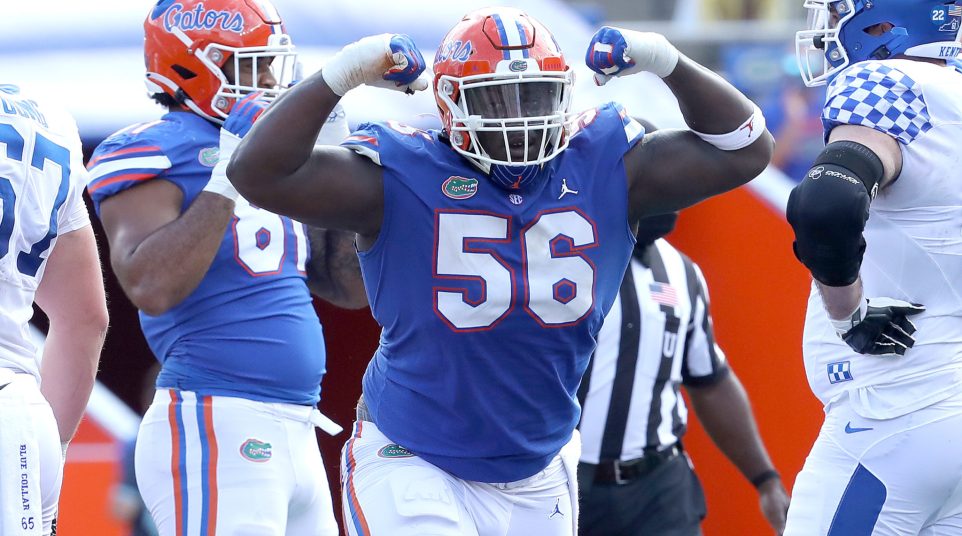
Florida football: Is the Gators defense showing signs of life?
Criticized throughout 2020, Todd Grantham’s defense put together its most complete performance of the season on Saturday in Florida’s 34-10 win over Kentucky. Sure, it took the Gators a half to figure out how to fit gaps and slow Kentucky’s power run game, and Florida fans would likely prefer Dan Mullen not have to lose his mind on Grantham just to coax the best out of the Gators defense. But Florida played their best game all the same.
Taking the glass-half-empty approach, it’s fair to point out that the performaance came against an anemic Kentucky offense that has posted 13 offensive points or fewer in 5 of their 9 games this season and ranks just 13th in the SEC in total offense and yards per play. The Gators should look sharp against Kentucky, and maybe it’s troubling it took about a half for the defense to lock in.
There’s also the glass-half-full approach. It suggests that after an abysmal start that saw the Gators rank in the bottom third of the country in total defense, yards allowed per play, pass efficiency defense and opponent success rate defense, Florida’s defense is showing signs of life across the board as the Gators enter the season’s home stretch.
Here’s a look at how an analytical analysis seems to show proof of life on defense for the Gators.
The run defense has improved significantly
Entering the Missouri game, Florida ranked 50th out of 100 teams in yards allowed per rush attempt and 61st in opponent rushing success rate, frightening numbers for a unit that ranked in the top 10 nationally against the run a season ago.
Florida now ranks 52nd in yards allowed per rush attempt, but that’s out of 126 teams, a modest improvement. The more significant improvement has been in success rate defense: Florida now ranks 39th. A top-40 mark in that area isn’t great, but it’s certainly an improvement, and it should encourage Florida fans headed down the stretch.
The Tennessee game scheduled for Saturday will be a great test of that improvement. The Vols have a very talented offensive line, and Eric Gray has run for 651 yards this season on 4.9 a pop, quality numbers against an SEC-only schedule.
Florida has struggled against the SEC’s best running backs, as Ole Miss’ Jerrion Ealy, Texas A&M’s Isaiah Spiller and South Carolina’s Kevin Harris have all had big days against the Gators. But it’s worth remembering that save 1 bust, Florida really limited an outstanding Georgia run game. And the Gators played the Aggies and Gamecocks without nose tackle Kyree Campbell, whose return to the fold after the Texas A&M game is a big reason Florida’s run defense has improved.
The pass rush has come to life
Florida languished in the 50s in sack percentage, quarterback pressures and havoc rate after their loss to Texas A&M. This all spelled very bad news for a defense already playing with a secondary prone to giving up explosive plays; the Gators left the A&M game ranked 12th in the SEC in explosive pass plays allowed.
The good news? Florida has seen big production increases thanks to the return of Campbell, who has occupied defenders inside, and the improved play of senior Zachary Carter and Georgia transfer Brenton Cox, who has been more active over the past 5 games.
The Gators aren’t leading the nation in sack percentage or rank top 5 in havoc, as they were a season ago. But they are now 35th out of 126 in sack percentage and an even better 22nd in quarterback pressures.
More than anything that the secondary has done to improve, you can credit Florida’s improving pass rush for helping the Gators rise from 98th in passing down success rate allowed heading into the Arkansas game to 65th now — a number that is right in the middle of college football, as opposed to miserable.
Coaching adjustments have keyed a vastly improved 2nd-half defense
Florida dominated the 4th quarter in Years 1 and 2 under Mullen, outscoring opponents by an average of more than a touchdown in the final frame. That strength has been negated in 2020. Early in the season, the Gators’ inability to get off the field on defense was especially pronounced in the 2nd half and 4th quarter. Florida surrendered 55 2nd-half points (of a total of 100) in the first 3 games, with 38 coming in the 4th quarter. Those are dreadful numbers, and a big reason Florida left College Station with a loss (the Aggies scored 17 4th-quarter points to rally for a 3-point win).
The Gators have improved dramatically in that regard since the COVID-19 pause. Florida has allowed only 24 4th-quarter points in their past 5 games, and 1o of those came in garbage time against Missouri with the Gators leading by 4 touchdowns. As a result, a Florida team that was outscored 38-20 in the 4th quarter in the first 3 games has flipped the script, outscoring their foes 38-24 in the 4th quarter over the past 5.
Florida has now allowed fewer 2nd-half points on the season than 1st-half points, despite the horrendous start, and has allowed only 7 2nd-half points in their past 2 games. Yes, those dominant 2nd-half performances came against Vanderbilt and Kentucky, but Mullen was quick to credit halftime adjustments this weekend, and the numbers seem to bear that out.
All told, the trend lines are looking better for the Florida defense. Yes, the group has only gone from “bad” to “average” from an analytical standpoint. But how good does it really need to be with an offense that ranks in the top 5 in success rate and efficiency? We’ll find out down the stretch, but at least for now, there are reasons to be encouraged.
